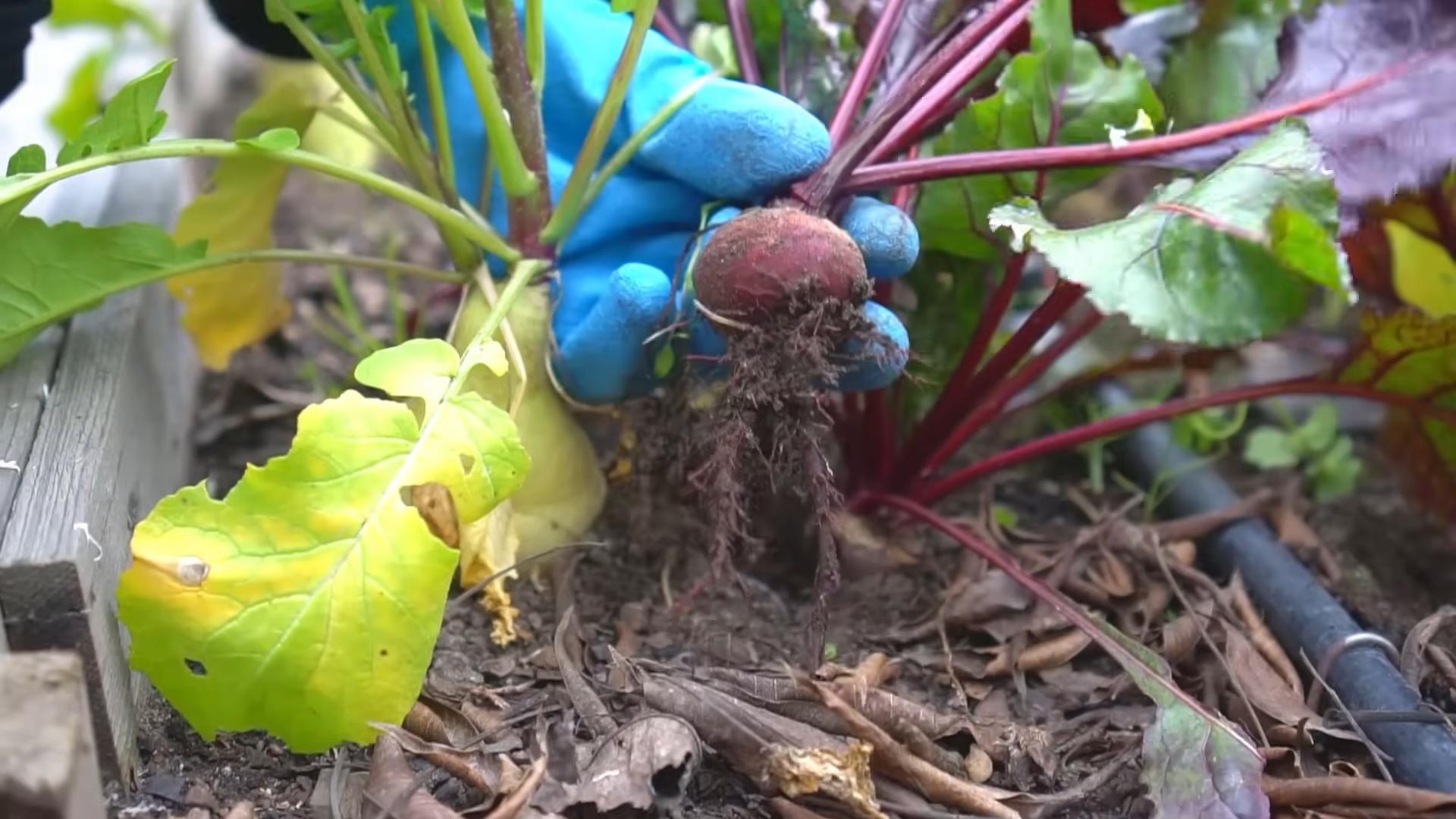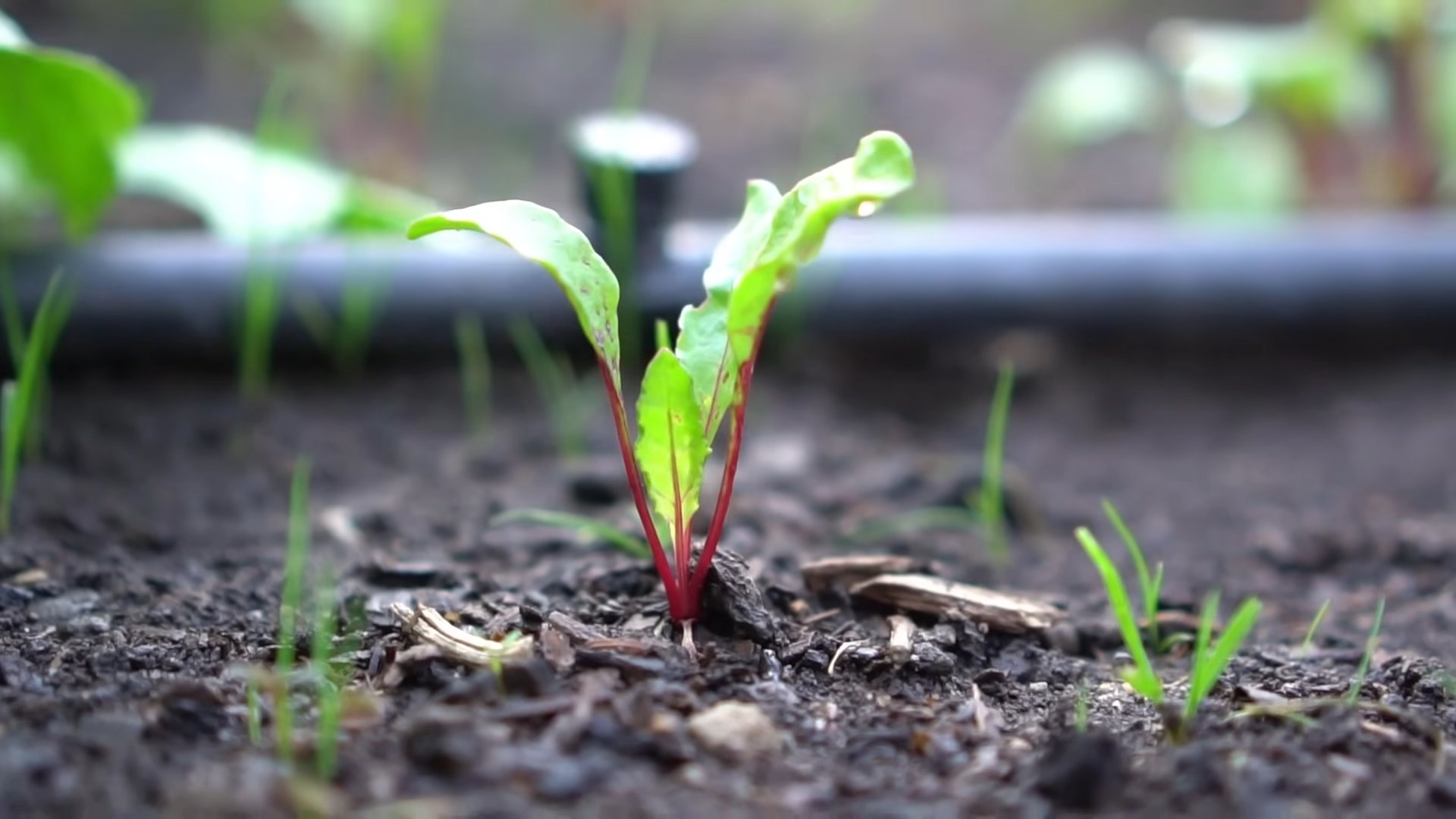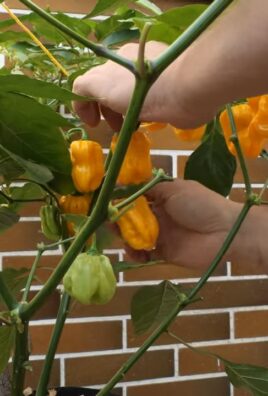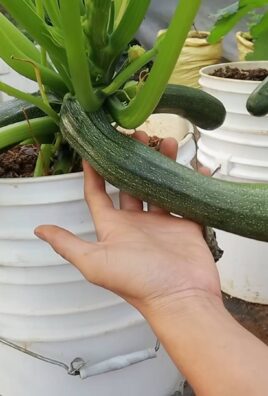Growing Beets at Home might seem intimidating, but trust me, it’s easier than you think! Imagine pulling vibrant, earthy beets straight from your own backyard, ready to be roasted, pickled, or added to a refreshing salad. Forget those bland, store-bought beets – homegrown flavor is in a league of its own.
Beets have a rich history, dating back to ancient times when their leafy greens were prized more than the root itself. The Romans were big fans, and over the centuries, beets have become a staple in cuisines worldwide, from Eastern European borscht to vibrant Mediterranean salads. But why leave all the fun to professional farmers?
In today’s world, we’re all looking for ways to connect with nature, eat healthier, and save a little money. That’s where these DIY tricks and hacks for growing beets at home come in! I’m going to share simple, step-by-step instructions and insider tips that will help you cultivate a thriving beet patch, even if you’re a complete beginner. Get ready to enjoy the satisfaction of harvesting your own delicious, nutritious beets – it’s a rewarding experience you won’t regret!

Growing Beets at Home: A Beginner’s Guide
Hey there, fellow gardening enthusiasts! I’m so excited to share my experience growing beets at home. Beets are not only delicious and nutritious, but they’re also surprisingly easy to cultivate, even if you’re a complete beginner. This guide will walk you through every step, from choosing the right variety to harvesting your vibrant, earthy treasures. Let’s get our hands dirty!
Choosing the Right Beet Variety
Before we even think about planting, let’s talk about beet varieties. There’s more to beets than just the standard red globe! Choosing the right variety depends on your taste preferences, growing conditions, and how you plan to use your harvest.
* Detroit Dark Red: This is a classic, reliable variety. It’s known for its deep red color, sweet flavor, and good storage capabilities. If you’re new to beet growing, this is a great place to start.
* Chioggia: Want something a little more visually interesting? Chioggia beets have beautiful red and white concentric rings inside. They’re milder in flavor than Detroit Dark Red and are best eaten fresh.
* Golden Beet: If you’re not a fan of the earthy taste of red beets, golden beets are a fantastic alternative. They’re sweeter and milder, with a lovely golden color that won’t stain your hands.
* Cylindra: As the name suggests, these beets are long and cylindrical, making them perfect for slicing and canning. They also mature relatively quickly.
* Baby Beet Varieties: If you’re short on space or just want a quick harvest, consider baby beet varieties. They mature faster and produce smaller, tender beets.
Preparing Your Beet Bed
Beets thrive in well-drained, fertile soil with a pH between 6.0 and 7.0. Before planting, it’s crucial to prepare your garden bed properly.
* Sunlight: Beets need at least 6 hours of sunlight per day. Choose a location in your garden that receives plenty of sunshine.
* Soil: Beets prefer loose, well-drained soil. Heavy clay soil can lead to misshapen roots. Amend your soil with compost or other organic matter to improve drainage and fertility.
* Testing the Soil: A soil test can tell you the pH and nutrient levels of your soil. You can purchase a soil test kit at most garden centers or send a sample to your local agricultural extension office.
* Removing Rocks and Debris: Beets need room to grow, so remove any rocks, sticks, or other debris from the planting area.
* Tilling or Digging: Loosen the soil to a depth of at least 12 inches. This will allow the beet roots to penetrate the soil easily.
* Adding Amendments: Incorporate compost, aged manure, or other organic matter into the soil. This will improve drainage, fertility, and water retention.
* Leveling the Soil: Rake the soil smooth to create a level planting surface.
Planting Your Beet Seeds
Beets are a cool-season crop, so the best time to plant them is in early spring or late summer.
* Timing: Plant beet seeds 2-4 weeks before the last expected frost in spring, or 6-8 weeks before the first expected frost in fall.
* Direct Sowing: Beets are best direct-sown, meaning you plant the seeds directly into the garden bed. They don’t transplant well.
* Seed Depth: Plant beet seeds about 1/2 inch deep and 1-2 inches apart.
* Row Spacing: Space rows 12-18 inches apart.
* Watering: Water the soil thoroughly after planting. Keep the soil consistently moist until the seeds germinate.
* Seed Germination: Beet seeds can be slow to germinate, taking 5-10 days. Be patient and keep the soil moist.
* Seed Clusters: Beet “seeds” are actually clusters of seeds. This means that multiple seedlings may emerge from each planting spot.
Thinning Your Beet Seedlings
Once your beet seedlings have emerged, it’s essential to thin them out. This will give the remaining plants enough space to grow and develop properly.
* When to Thin: Thin your beet seedlings when they are 2-3 inches tall.
* How to Thin: Carefully pull out the extra seedlings, leaving the strongest plant in each spot.
* Spacing: Aim for a final spacing of 3-4 inches between plants.
* Don’t Waste the Thinnings: You can eat the thinned seedlings! They’re delicious in salads or as a microgreen garnish.
Caring for Your Beet Plants
Beets are relatively low-maintenance, but they do need some care to thrive.
* Watering: Water your beet plants regularly, especially during dry periods. Beets need consistent moisture to develop properly. Aim for about 1 inch of water per week.
* Weeding: Keep your beet bed free of weeds. Weeds compete with beets for water and nutrients. Hand-pull weeds carefully to avoid disturbing the beet roots.
* Fertilizing: Beets are not heavy feeders, but they do benefit from a light feeding of fertilizer. Use a balanced fertilizer or side-dress with compost. Avoid over-fertilizing, as this can lead to excessive foliage growth at the expense of root development.
* Mulching: Apply a layer of mulch around your beet plants to help retain moisture, suppress weeds, and regulate soil temperature. Straw, wood chips, or shredded leaves are all good options.
* Pest Control: Beets are generally pest-resistant, but they can be susceptible to certain pests, such as flea beetles and leaf miners. Inspect your plants regularly for signs of pests and take action if necessary. Insecticidal soap or neem oil can be effective for controlling many common beet pests.
* Disease Control: Beets can also be susceptible to certain diseases, such as leaf spot and damping-off. Prevent disease by providing good air circulation, avoiding overwatering, and practicing crop rotation.
Harvesting Your Beets
The moment we’ve all been waiting for! Knowing when to harvest your beets is key to getting the best flavor and texture.
* Timing: Beets are typically ready to harvest 50-70 days after planting, depending on the variety.
* Size: Harvest beets when the roots are 2-3 inches in diameter. You can also harvest them earlier for baby beets.
* Checking for Readiness: Gently brush away the soil around the base of the beet to check its size.
* Harvesting Technique: Grasp the beet greens near the base and gently pull the beet out of the ground. If the soil is dry, you may need to loosen it with a garden fork first.
* Handling: Handle beets carefully to avoid bruising them.
* Greens: Don’t throw away the beet greens! They’re delicious and nutritious. You can cook them like spinach or add them to salads.
* Cleaning: Brush off any excess soil from the beets.
* Storage: Store beets in a cool, dark, and humid place. Cut off the greens, leaving about 1 inch of stem attached. Store the beets in a plastic bag in the refrigerator for up to several weeks.
Enjoying Your Homegrown Beets
Now for the best part – enjoying the fruits (or rather, roots!) of your labor.
* Roasting: Roasting beets brings out their natural sweetness. Toss them with olive oil, salt, and pepper, and roast them in a 400°F oven for 30-45 minutes, or until tender.
* Boiling: Boiling is another simple way to cook beets. Boil them until tender, then peel and slice them.
* Pickling: Pickled beets are a classic treat. They’re sweet, tangy, and perfect for adding to salads or sandwiches.
* Salads: Add sliced or diced beets to your favorite salads for a boost of flavor and nutrition.
* Beet Juice: Beet juice is a healthy and refreshing drink. You can juice beets raw or cooked.
* Beet Greens: Sauté beet greens with garlic and olive oil for a simple and delicious side dish. You can also add them to soups, stews, or stir-fries.
* Beet Soup (Borscht): Borscht is a traditional Eastern European soup made with beets. It’s hearty, flavorful, and perfect for a cold day.
Troubleshooting Common Beet Growing Problems
Even with the best care, you might encounter some problems while growing beets. Here are a few common issues and how to address them:
* Poor Germination: If your beet seeds aren’t germinating well, make sure the soil is consistently moist and the soil temperature is warm enough. You can also try soaking the seeds in

Conclusion
So, there you have it! Growing beets at home is not only achievable, but it’s also a deeply rewarding experience that connects you to the food you eat in a tangible way. From the vibrant greens that add a peppery kick to salads to the earthy sweetness of the roots themselves, beets offer a culinary versatility that’s hard to beat.
Why is this DIY trick a must-try? Because it puts you in control. You choose the variety, you nurture the plants, and you harvest at the peak of freshness. Store-bought beets simply can’t compete with the flavor and satisfaction of homegrown. Plus, you’re reducing your carbon footprint by shortening the distance your food travels.
But the benefits extend beyond just taste and sustainability. Gardening is therapeutic. It’s a chance to slow down, connect with nature, and de-stress. The simple act of tending to your beet plants can be incredibly calming and grounding. And let’s not forget the educational aspect – especially if you have children. Growing beets at home is a fantastic way to teach them about where their food comes from and the importance of healthy eating.
Ready to take your beet growing to the next level? Consider these variations and suggestions:
* Succession Planting: Plant a new batch of beet seeds every few weeks to ensure a continuous harvest throughout the growing season.
* Companion Planting: Beets thrive alongside other vegetables like onions, garlic, lettuce, and cabbage. Experiment with companion planting to improve growth and deter pests.
* Roast Beet Greens: Don’t throw away those beautiful beet greens! Toss them with olive oil, salt, and pepper, and roast them in the oven for a delicious and nutritious side dish.
* Pickled Beets: Preserve your beet harvest by pickling them. Pickled beets are a tangy and flavorful addition to salads, sandwiches, and charcuterie boards.
* Beet Juice: Juice your beets for a healthy and refreshing beverage. Beet juice is packed with nutrients and antioxidants.
* Different Varieties: Explore different beet varieties beyond the standard red. Golden beets offer a milder flavor, while Chioggia beets boast beautiful pink and white rings.
We’ve armed you with the knowledge and inspiration to embark on your beet-growing adventure. Now it’s your turn to get your hands dirty! We encourage you to try growing beets at home, even if you only have a small balcony or patio. The rewards are well worth the effort.
Don’t be afraid to experiment, learn from your mistakes, and most importantly, have fun! And once you’ve harvested your first crop of homegrown beets, we want to hear all about it. Share your experiences, tips, and photos with us in the comments below. Let’s build a community of beet-loving gardeners! We are confident that you will find that growing beets at home is a great experience.
FAQ
What is the best time of year to plant beets?
The ideal time to plant beets depends on your climate. In general, beets are a cool-season crop, meaning they thrive in temperatures between 60°F and 70°F (15°C and 21°C). For a spring crop, sow seeds 2-4 weeks before the last expected frost. For a fall crop, sow seeds 6-8 weeks before the first expected frost. If you live in a region with mild winters, you may be able to grow beets year-round. Check your local gardening resources for specific planting dates in your area.
What kind of soil do beets need?
Beets prefer well-drained, loose soil that is rich in organic matter. The ideal soil pH is between 6.0 and 7.0. Before planting, amend your soil with compost or well-rotted manure to improve drainage and fertility. Avoid soils that are heavy in clay, as they can hinder root development. If you have clay soil, consider growing beets in raised beds or containers.
How much sunlight do beets need?
Beets need at least 6 hours of sunlight per day to thrive. Choose a planting location that receives full sun for optimal growth. If you live in a hot climate, some afternoon shade can be beneficial to prevent the leaves from scorching.
How often should I water my beet plants?
Beets need consistent moisture to develop properly. Water deeply and regularly, especially during dry periods. Aim to keep the soil consistently moist but not waterlogged. A good rule of thumb is to water when the top inch of soil feels dry to the touch. Mulching around your beet plants can help retain moisture and suppress weeds.
How far apart should I plant beet seeds?
Sow beet seeds about 1 inch deep and 1-2 inches apart in rows that are 12-18 inches apart. After the seedlings emerge, thin them to 3-4 inches apart to allow the roots to develop properly. You can eat the thinned seedlings as microgreens.
When are beets ready to harvest?
Beets are typically ready to harvest 50-70 days after planting. The size of the beet roots will vary depending on the variety, but most are ready to harvest when they are 1-3 inches in diameter. You can also harvest the beet greens at any time. To harvest the roots, gently loosen the soil around the beets and pull them out of the ground.
Why are my beet greens growing, but not the roots?
There are several reasons why your beet greens might be growing well, but the roots are not developing properly:
* Overcrowding: If the beet plants are too close together, they will compete for resources and the roots will not have enough space to grow. Thin the seedlings to 3-4 inches apart.
* Poor Soil: Beets need loose, well-drained soil to develop properly. If the soil is compacted or heavy in clay, the roots will struggle to grow. Amend the soil with compost or well-rotted manure.
* Lack of Nutrients: Beets need adequate nutrients to grow. If the soil is deficient in nutrients, the roots will not develop properly. Fertilize your beet plants with a balanced fertilizer or compost tea.
* Too Much Nitrogen: While beets need nutrients, too much nitrogen can promote leafy growth at the expense of root development. Avoid using fertilizers that are high in nitrogen.
* Inconsistent Watering: Beets need consistent moisture to develop properly. If the soil is allowed to dry out, the roots will not grow well. Water deeply and regularly, especially during dry periods.
Can I eat beet greens?
Yes, beet greens are delicious and nutritious! They can be eaten raw in salads or cooked like spinach. Beet greens are a good source of vitamins A and C, as well as iron and fiber.
How do I store beets after harvesting?
To store beets, cut off the greens, leaving about 1-2 inches of stem attached. Gently brush off any excess soil, but do not wash the beets. Store the beets in a cool, dark, and humid place, such as a root cellar or refrigerator. They can be stored for several weeks or even months under the right conditions.
Are there any pests or diseases that affect beets?
Beets are generally resistant to pests and diseases, but they can be affected by a few common problems:
* Leaf Miners: Leaf miners are small insects that tunnel through the leaves of beet plants, leaving behind unsightly trails. Control leaf miners by removing and destroying infested leaves.
* Flea Beetles: Flea beetles are small, jumping insects that can damage beet leaves. Control flea beetles by using row covers or applying insecticidal soap.
* Downy Mildew: Downy mildew is a fungal disease that can cause yellow spots on beet leaves. Prevent downy mildew by providing good air circulation and avoiding overhead watering.
* Cercospora Leaf Spot: Cercospora leaf spot is another fungal disease that can cause brown spots on beet leaves. Control Cercospora leaf spot by removing and destroying infected leaves and applying a fungicide.




Leave a Comment